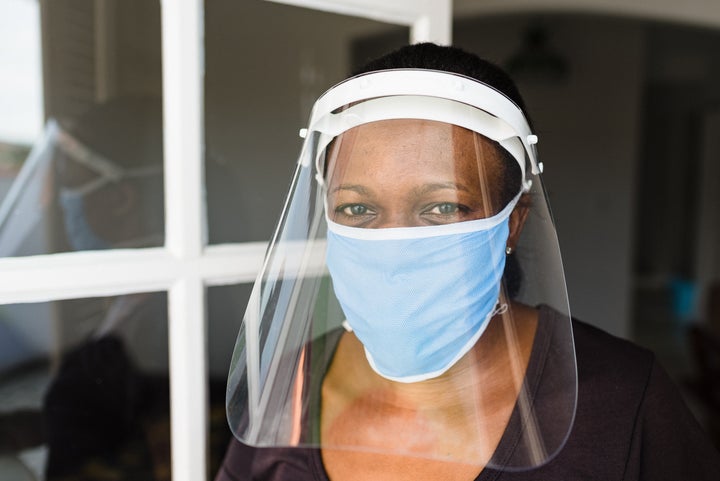We’re here to guide you through the coronavirus pandemic. Sign up to the Life newsletter for daily tips, advice, how-tos and escapism.
Face shields are becoming an increasingly common sight as lockdown eases, particularly as people head back to work.
In hairdressers, barbers and beauty salons, where employees come into close contact with customers, workers have been urged to wear extra protection such as clear visors that cover the face – especially if physical distancing isn’t possible.
A face shield “provides a barrier between the wearer and the client from respiratory droplets caused by sneezing, coughing or speaking,” the UK government advice states.
On their own, face shields can help protect the wearer from a cough or sneeze a short distance away – essentially, it stops droplets landing on your face or being inhaled through your nose or mouth. But studies have found smaller aerosols can travel up and underneath the shield.
This is particularly important as the World Health Organisation (WHO) has said it cannot rule out the possibility that Covid-19 may be airborne.

A study of healthcare workers found wearing a face shield reduced exposure to flu by 96% in the period immediately after a cough – from 18 inches away. But in the context of a smaller cough aerosol, the face shield was less effective, blocking only 68% of the cough.
In the half an hour period after a cough, during which the aerosol had dispersed throughout the room and larger particles had settled, the face shield was even less effective, the study found – with researchers concluding that people wearing face shields can still inhale infectious airborne particles.
“They cannot be used as a substitute for respiratory protection when it is needed,” researchers concluded of face shields.
But what about in a public setting? Dr Julian Tang, honorary associate professor in respiratory sciences at the University of Leicester, tells HuffPost UK that face shields are “better than nothing”.
He is not alone in recommending wearing a shield and face mask together for “added protection”.
Face shields and visors have the added advantage that they include eye protection, says Dr Tang. This is important as there’s potential for the virus to enter the body through mucous membranes in the eyes.
Shields are also washable and re-useable, and less claustrophobic than masks, he adds, while also allowing for normal communication if worn instead of a face mask – concerns have been raised that opaque face masks and covers make lip-reading impossible for those who rely on it to communicate.
To work best, face shields should fit certain criteria, he says, including:
– Curving around the sides of the face to the ears to reduce aerosols entering from the sides.
– Extending down long enough in front of the face to reduce aerosols from entering underneath the shield.
– Having a tight seal between the top of the face shield and the forehead to reduce the number of aerosols entering from above.
Jennifer Veltman, chief of infectious diseases at Loma Linda University Health in California, says face shields could be useful for people who cannot wear masks, but notes that masks remain the number one form of protection.
Dr David Strain, a clinician at the Royal Devon and Exeter Hospital, previously told HuffPost UK that face shields on their own are not protective and should be worn in addition to a face mask, rather than as a replacement.
His words are echoed by MIT Medical, which said face shields are not an adequate substitute to face masks as they let the wearer’s droplets escape – and the purpose of mask-wearing is that you do it to protect those around you.
There is a concern that if face shields are worn without a face cover or mask underneath, the wearer’s breath (and therefore, droplets) can be propelled in a strong jet of air downwards.
A pre-print study from the University of Edinburgh on the effectiveness of different types of face cover in protecting against Covid-19 found different shield shapes result in different jets but, unless curved below the chin, they were likely to generate an “intense and fast downward jet” which could be a “significant hazard” if the wearer is standing near a seated person. For example, a hairdresser and client, or restaurant server and customers seated at a table.
One Swiss doctor Marina Jamnicki warned restaurants in Switzerland against using plastic visors after an analysis found they didn’t offer sufficient protection and people who wore them actually got infected, Reuters reported.
Dr Stephen Griffin, associate professor at the University of Leeds’ school of medicine, tells HuffPost UK face shields “do very little” to prevent the onward transmission of droplet/aerosol-borne viruses as they merely direct the airflow downwards. “This is therefore not the same as wearing a face covering/mask,” he says.
Face shields are often worn by healthcare workers during high-risk scenarios in addition to fitted, filtered masks and eye protection – these three measures in combination help to reduce exposure to virus, he points out. “I would not recommend the wearing of face shields by the general public,” says Dr Griffin.
Ultimately, whether you choose to wear a face shield or not is your choice. But if you do wear one, remember to team it with hand-washing, physical distancing and catching coughs and sneezes in tissues before binning them.
For extra protection – and to protect those around you – add a mask.
